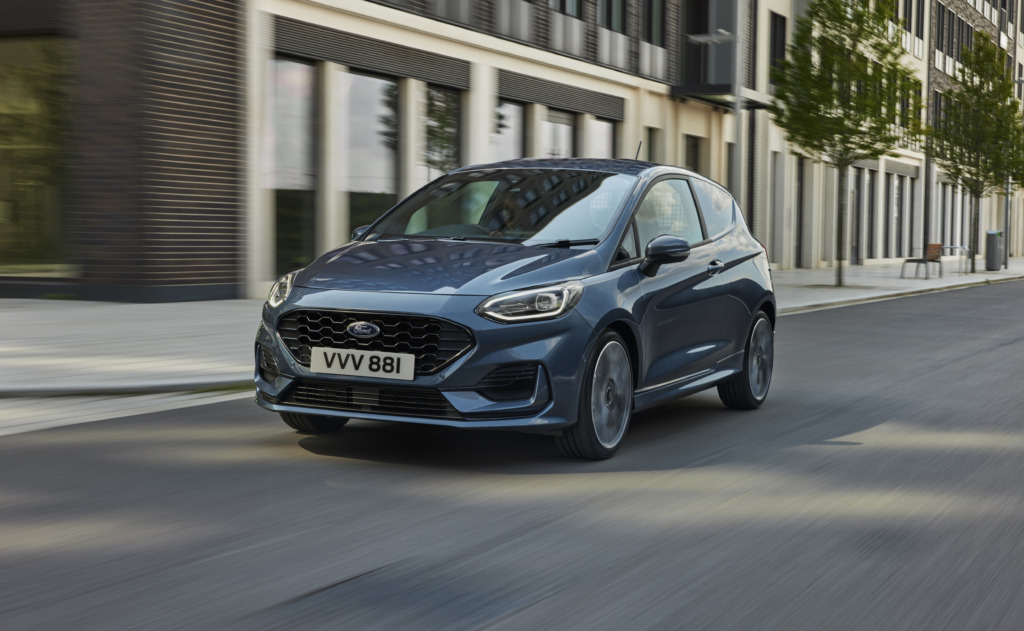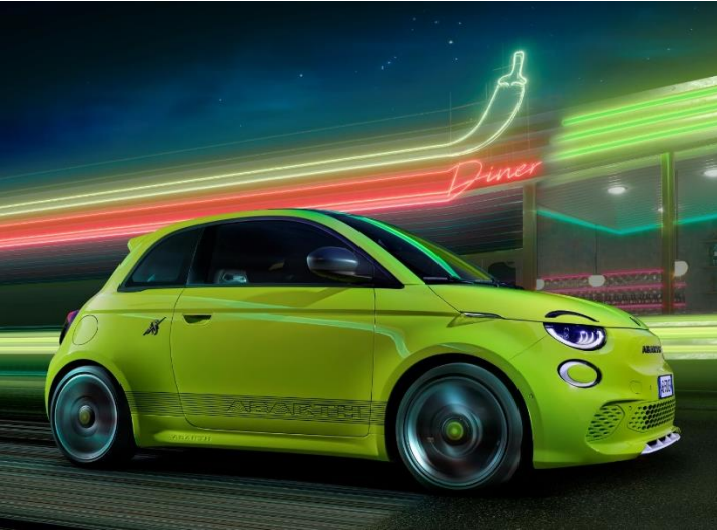The much improved Ford Fiesta Van looks to be made of the right stuff.
Background
This much improved Ford Fiesta Van gets off to a great start in life in being based on the latest version of the brand’s seventh generation Fiesta supermini. The carrying capacity isn’t huge but its driving experience, design and build quality should please potential customers, as will the efficiency of the available mild hybrid engine tech.
There used to be plenty of options if you wanted a really small city-sized van. Today though, if that’s what you need, a Ford is almost certainly what you want. Maybe this one, the Fiesta Van, here offered in its latest improved form. The Blue Oval brand still thinks there’s a customer need for tiny LCVs like this. Are they right?
Perhaps. Size, after all, isn’t everything when it comes to vans. In fact, for a certain kind of customer, small is beautiful – as will be the case when it comes to an LCV if, for instance, your business only delivers very small items in congested urban areas. Ford has been producing its Fiesta Van to cater for this need ever since 1976 and in 2014, widened its offering in the city van sector to also include the Fiesta-based Transit Courier van, for those wanting the same small roadway footprint but a slightly larger ‘hi-cube’-style load capacity.
But small business like florists and couriers often don’t need much space in the back and for them, the older approach to small van design – that of simply taking a supermini and doing little more than removing the rear seats and blanking out the rear windows – works just fine. All the main LCV brands used to populate this part of the van market, either with supermini-derived vans or hi-cube-style ones. Now though, things are very different. In fact, these days the only brand still competing with Ford in the cityvan segment is Fiat – and their Fiorino hi-cube van is in its last run-out phase. Every other LCV manufacturer will try and sell you an entry-level version of a family hatch-based model from the next class up – something like Ford’s own Transit Connect model. And that might not really be what you actually need.
The Ford Fiesta Van Driving Experience
On the road, if you’re familiar with the previous generation Fiesta van, your experience should be that this model has a more solid feel. There’s a choice of a couple of three cylinder 1.0-litre EcoBoost petrol engines, a conventional one with 95PS and a mild hybrid version with 125PS. Both come mated to 6-speed manual transmission. With the mid hybrid version of this three cylinder unit, a belt-driven integrated starter/generator (BISG) in place of the standard alternator enables recovery and storage of energy usually lost during braking and coasting to charge a 48-volt lithium-ion air-cooled battery pack. The more powerful BISG also enables the Fiesta Van EcoBoost Hybrid’s Auto Start-Stop technology to operate in a wider range of scenarios for even greater fuel savings, including when coasting to a stop below 15mph and even when the vehicle is in gear with the clutch pedal depressed.
All Fiesta van models handle vastly better than you’d expect any LCV to be able to do. With this seventh generation model, things have been improved in this regard by a 15% stiffening of the body and a widening of the front and rear tracks. The vehicle’s light weight and low-set driving position also give a feeling of sportiness, plus there’s plenty of feedback through the improved electric steering rack. Upgrade yourself from a standard Fiesta Van model to the Sport Van variant and you get lowered sports suspension, rear disc brakes and larger wheels that can be anything between 17 to 18-inches in size, depending on the final spec you choose.
The Ford Fiesta Van Design and Build
Once upon a time, the small van market was completely made up of supermini-derived models like this one but in recent times, most buyers have been drawn towards purpose-designed small vans that aren’t constricted by passenger car styling and so can offer much larger carrying capacities without taking up any more road space. Ford’s own Transit Courier model is a good example of this approach and if you really need carrying capacity, models like that one are indeed a better bet – but then, if you really need that, should you really be considering a very small van in the first place? If having considered that, you conclude that your needs are less cubic capacity-orientated, then this Fiesta van might prove to be a very effective choice.
The styling of this commercial Fiesta has been revised in this improved form, with a bonnet design that increases the height of the nose, combined with larger upper grilles. The Ford ‘blue oval’ badge is now displayed within the grille, rather than on the bonnet lip, contributing to greater road presence. There are smarter standard LED headlights and the taillights receive black surrounds. Base ‘Trend’ trim variants are marked out by a broad upper grille with strong horizontal strakes and high-gloss chrome surround, as well as 15-inch steel alloys with a smart wheel trim design. ‘Sport’ models boost a honeycomb grille with gloss black finish and wide, body-coloured side vents, plus there are 17-inch metallic-finish alloy wheels, with 18-inchers being optional.
The cabin incorporates the latest interior technologies, including Ford’s SYNC 3 communications and entertainment system. ‘Sport’ models also benefit from two-tone red and ebony interior trim with contrast red stitching.
The Ford Fiesta Van Market and Model
Prices are a little above those of the previous model, which means a launch starting point (excluding VAT) of £16,715 for base ‘Trend’-spec. For customers wanting a bit more sporting style for their business, the Fiesta Van is also available as a ‘Sport’ model (£16,790 ex-VAT), with unique front and rear design treatment, colour-coded rocker panels and up to 18-inch alloy wheels. The sporting theme continues inside the cabin, with revised seats and trim materials, plus a unique design for the steering wheel, pedals and gear lever. An Adjustable Speed Limiter and a Lane Keeping System are fitted to this variant as standard.
For this latest model, Ford has updated its ‘SYNC 3’ communications and entertainment system. When specified with navigation, it now features an onboard ‘FordPass Connect’ modem, which enables a powerful suite of tools to boost owner productivity and simplify the working day. These include remote unlocking and data-driven maintenance alerts through the ‘FORDLiive connected uptime system’, delivered via the ‘FordPass Pro’ mobile app or Ford Telematics.
As before, the ‘SYNC 3’ screen is compatible with the ‘Apple CarPlay’ and ‘Android Auto’ smartphone-mirroring systems. Safety kit includes Ford’s PreCollision Assist with Pedestrian Detection emergency braking system, Adaptive Cruise Control and Blind Spot Information System. Plus there’s Active Park Assist with Perpendicular Parking and Cross Traffic Alert to support easy and safe parking, along with Traffic Sign Recognition and Adjustable Speed Limiter to help avoid speeding fines.
The Ford Fiesta Van Practicalities and Costs
In terms of practicality, as we’ve said, you won’t be buying a supermini-derived small van if interior space is everything. That point made, it’s also worth saying that this Ford does at least enable its owner to make good use of the space that is on offer. Inside the three-door body, there is a practical load compartment capable of carrying approximately 1.0 cubic metre of cargo with a load length of almost 1.3 metres and gross payload of around 500kg. The load space features a composite and mesh full bulkhead, durable sidewall trim and a tough rubber floor covering with four tie-down hooks.
A 12-year anti-perforation guarantee goes a long way to reassure buyers of Ford’s faith in their product’s capacity not to fall foul of Mr rust and if all goes to plan, the 1-year breakdown cover will be surplus to requirements. As for running costs, well to prioritise these, you need the 1.0T EcoBoost Hybrid which returns 55.4mpg on the WLTP combined cycle and 99g/km of WLTP CO2. For the conventional version of this engine, the figures are 55.4mpg and 101g/km.
Summary
Ford knows exactly how to build a class-leading supermini-derived van – but then, with a passenger car product as good as the Fiesta to base it on, you’d think that the van version’s designers had very little to do to complete an excellent product.
Perhaps the best part about this commercial vehicle is that it doesn’t look like one. All the style that marks out the Fiesta car has been transferred over intact – and that should make it a good advert for the kind of small businesses (florists, gardeners and so on) likely to want a vehicle of this kind. Imagining your company logo on the doors? Then get in touch.





